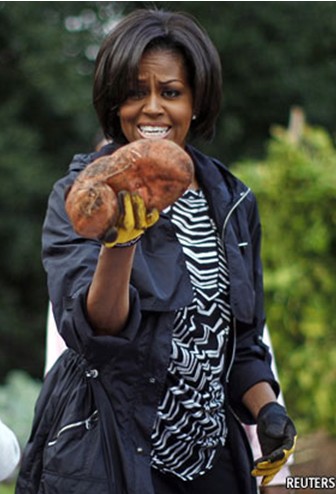『为减少国民高热量食物以及垃圾食品的摄入量,美国政府以及相关部门积极采取行动改善国民的饮食习惯 』
Food fights
食物大战
Jun 16th 2011 | from The Economist

“ENJOY your food, but eat less.”“Make half your plate fruits and vegetables.” This is not advice from your mother, but carefully crafted, consumer-tested wisdom from the United States Department of Agriculture (USDA). Earlier this month the USDA and Michelle Obama, the first lady, unveiled these messages and a new dietary icon. “MyPlate” shows a table setting with portions of fruit, vegetables, grains and protein, with a small side-order of dairy. The image is supposed to represent a healthy diet. For many Americans it might as well be a meal from Mars.
It is no secret that a lot of Americans eat rubbish. MyPlate is just one piece of a broader effort to promote healthy foods. The Food and Drug Administration (FDA) is considering new health labels for the front of food packages. Four federal agencies have proposed new guidelines for food marketing to children; companies are furiously preparing comments ahead of a deadline on July 14th. There is lots of activity. Progress, however, will be slow.
Mrs Obama is waging a multi-front war against childhood obesity. Few would object to vegetable gardening and hula-hooping, but efforts around marketing food are more contentious. MyPlate is the least divisive project. The USDA issued new dietary guidelines in January; MyPlate will help to convey those guidelines to the average consumer. MyPlate is a vast improvement over the last dietary icon, an incomprehensible colour-coded pyramid. MyPlate presents a clearer message and stresses the importance of fruits and vegetables. But it may have little effect. The government regularly issues dietary guidelines. Consumers regularly ignore them. In 2007-08 the average adult consumed about half the recommended servings of fruit and vegetables and nearly twice the upper limit for solid fats and added sugars.
It does not help that Americans are bombarded with other health messages. Particularly confusing has been the proliferation of health icons that adorn food packaging. In 2004 PepsiCo, for example, launched a “Smart Spot” logo. The American Heart Association adorns certain products with a “heart check” mark. Each of these icons has its own nutritional criteria, some grossly misleading. Big food companies endorsed a common “Smart Choices” label, only to abandon it in 2009 after outcry over its use on Cocoa Krispies.
That year the FDA began studying whether a standard for such labels might help to distinguish healthy foods from junk ones, as is the case in Britain. But America’s food industry pre-empted the FDA by launching its own “Nutrition Keys” labelling system in January. The FDA’s effort is still crawling forward.
A fight over advertising, meanwhile, is heating up. In 2005 the Institute of Medicine found that television advertising influenced young children to prefer unhealthy foods and drinks. In 2009 Congress asked a working group of four federal agencies to devise guidelines for food marketed to children. In April the agencies presented voluntary guidelines, at last. Their proposal would bar companies from advertising products to children that fail to meet strict nutritional standards. The guidelines would cover virtually all types of marketing.
The food industry claims that its own campaign, has reduced junk-food ads and that few products would meet the government’s standards. “Unworkable,” Elaine Kolish, the campaign’s director, says of the new guidelines. The fight may drag on. Congress originally asked the agencies to issue their recommendation by July 2010. Meanwhile, American children continue to gobble up sugar and fat. Nearly one-third of them are overweight or obese.
上一篇:考研阅读精选:暴力影片有“益处”








